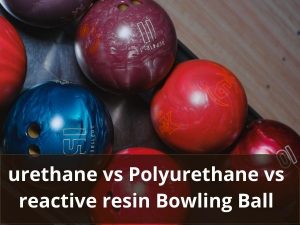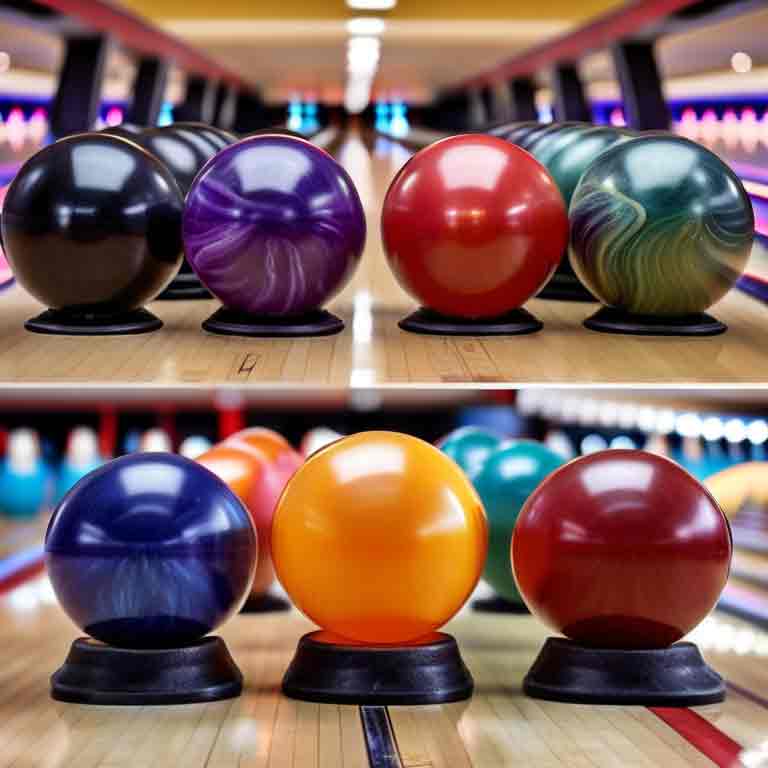Urethane vs Polyurethane vs Reactive Resin Bowling Ball Differences: Simple & Easy Guide In 2024!
Urethane Vs Polyurethane Vs Reactive Resin Bowling Ball Differences! Finding the perfect bowling ball might not be too hard if you know what you’re looking for. One of the most important factors of a bowling ball is its coverstock. If you don’t know much about your ball’s exterior you won’t understand what kind of ball reaction and motion you will experience. Today, I’m here to present to you the common differences and similarities between urethane, polyurethane, and reactive resin bowling balls.
So in a battle between urethane vs polyurethane vs reactive resin bowling balls, which one do you think will win? If you have no prior knowledge, let me guide you through what to expect from each coverstock. Let’s begin, shall we?

Basic Differences
While all have their pros and cons, Urethane and Polyurethane bowling balls are great if you love to control your bowling balls. This gives you more predictability than Reactive resin balls. On the other hand, reactive resins are less durable than urethanes but better at top-notch performance because they hook compared to any other bowling balls.
Related Post
How to Measure Bowling Ball Speed Manually In Accurate Way
What is Urethane Bowling Ball?
Typically, you get to play with plastic or urethane bowling balls in your local bowling alley. The urethane bowling balls are more durable than plastics and less advanced than reactive resin. After urethane was first introduced in the market back in the 1980s, bowlers were all over it. As the name suggests, its material is urethane.
Urethane bowling balls make a handsome choice for both professionals and new/regular trainees. Compared to a plastic ball, a urethane coverstock bowling ball offers more friction down lane before ensuring an excellent entry angle to the pockets. The higher friction of urethane also makes the ball hook with a better pin action. Because these balls don’t hook much on oily lanes, you’ll see the best performance on medium or dry lanes. For moderate control over the ball’s motion, reaction, and breakpoint, Urethane coverstock balls are just the thing for you.
What is Polyurethane Bowling Ball?
There aren’t a lot of differences between urethane and polyurethane. A urethane ball can be made of polyurethane. Polyurethane is a polymer. Bowling balls that are made of polyurethane tend to be much more durable than urethane balls, This material consists of repeating units that are chemically linked in a very specific pattern. Some of these repeating units fall under the urethane groups. So basically, what it means is that a polyurethane object has multiple urethane groups. This is exactly why these bowling balls are harder, stronger, and long-lasting.
In terms of performance, urethane and polyurethane bowling balls perform the same. So if you want your bowling balls to last longer, go for a polyurethane bowling ball. Some manufacturers have already changed their urethane material to polyurethane to make their urethane bowling balls. So before you spend your money on a bowling ball, make sure you know the kind of material you will be getting.
What is a Reactive Resin Bowling Ball?
Although Reactive Resin was introduced to the market after urethane bowling balls it is less durable. So what are the advantages of these balls? Well, reactive resins offer more hook potential, better friction down lane, and amazing pin action. In terms of the materials, Reactive and urethane coverstocks have quite similar formations. However, reactive resins have some special additives mixed with the formula that create the differences.
Compared to urethane or polyurethane bowling balls, Reactive Resins are a bit complex to control. If you’re into hooking your bowling ball, Reactive resins make an excellent choice. Honestly, you can’t go wrong by adding a reactive resin to your arsenal. These bowling balls are sub-categorized into three different types— Reactive Solids, Reactive Pearls, and Reactive Hybrid. Some reactive resins provide extra traction, smooth motion, and a stronger backend reaction, while others are more prone to hook and sensitive to the lane conditions. Each has its special hook-ability and ball motion capabilities.
Differences between Urethane Bowling Ball Polyurethane Bowling Ball and Reactive Resins Bowling Ball
Apart from the differences in material and its formation, urethane, polyurethane, and reactive resin bowling balls perform pretty differently. Let me break it down for you.
Hooking ability:
Unless you don’t want your bowling ball to hook, it’s better not to go for reactive resin bowling balls. Why? Because urethane or polyurethane tends to be more beginner friendly, it hooks less. Moreover, many professional bowlers often prefer urethane over any other reactive resin bowling balls. But for those who enjoy the higher hook potential in their game, a reactive resin ball is a better option. This is because higher hook potential promotes on-point pin action. This is something many bowlers need to improve their average.
Durability:
If I have to put these three kinds of balls in order in terms of their durability, polyurethane comes first, then urethane, and lastly reactive resins. Because polyurethane contains multiple repeating units of urethane it tends to be stronger and less prone to cracking. If you want to make your bowling balls last forever, a polyurethane bowling ball will do you good.
Density and weight:
Reactive resins bowling balls tend to be heavier than urethane and polyurethane bowling balls. This is because reactive resin coverstocks have a higher density than urethane and polyurethane. Polyurethane is slightly denser than your regular urethane bowling balls. Hence, the higher durability.
Ball performance:
Because reactive resins have a high hook potential, it offers better friction down the lane and an exceptional pin reaction than any urethane bowling balls. However, when it comes to control and flexibility, urethane bowling balls win. Polyurethane and Urethane bowling balls react almost the same way. Urethane bowling balls are suitable for both beginners and pro players. On the other hand, beginners will find it a bit tough to play with reactive resins.

FAQs Of Urethane Vs Polyurethane Vs Reactive Resin Bowling Ball Differences!
What is the main difference between Urethane and Polyurethane bowling balls?
- Urethane bowling balls are made from a solid urethane coverstock and are known for their smoother, controllable hook potential. Polyurethane bowling balls are typically a type of plastic, not meant for hooking, and are used mainly for spare shooting.
How do Reactive Resin bowling balls differ from Urethane and Polyurethane balls?
- Reactive Resin bowling balls have a porous, grippy surface and are designed for maximum hook potential. They react more to lane conditions and generate more angular motion compared to Urethane and Polyurethane balls.
Are Polyurethane balls good for beginners?
- Yes, Polyurethane balls are often recommended for beginners due to their straighter trajectory and predictable motion. They’re easier to control and can help beginners work on their accuracy.
Which type of bowling ball is better for hooking power?
- Reactive Resin bowling balls offer the most hook potential and are favored by advanced bowlers looking for maximum power and angular motion. Urethane balls offer moderate hooking, while Polyurethane balls are not designed for hooking power.
Conclusion
If you set a battle between urethane vs polyurethane vs reactive resin, who do you think will win? Yeah, I know. It’s hard to draw a conclusion. Each ball has its special and effective features. Therefore, it’s up to a bowler’s preference which bowling ball is right for them. On that note, I hope this article was insightful enough to help you understand urethane, polyurethane, and reactive resin bowling balls better. Cheers and happy bowling!

Passionate Bowler and Bowling Enthusiast
Jess Pinelli is a dedicated bowling enthusiast with a deep love for the sport that spans over 6 years. With numerous strikes, spares, and a few gutter balls under hes belt, he has honed his skills on lanes across the country. Pinelli’s journey in the world of bowling has been a remarkable one, from casual weekend games with friends to competitive league play and even a few local tournaments.
Driven by her passion for the game, Pinelli decided to channel her expertise and knowledge into the digital realm, becoming a prolific author on this bowling website. She’s your go-to source for everything bowling-related, from mastering the perfect hook to choosing the right bowling ball and even navigating the world of bowling etiquette.
When she’s not busy writing informative articles or reviewing the latest bowling gear, you’ll likely find Pinellis at her favorite local bowling alley, helping newcomers improve their game or enjoying some friendly competition with fellow bowlers. She firmly believes that bowling is not just a game but a community, and she’s committed to fostering that sense of camaraderie both online and offline.
